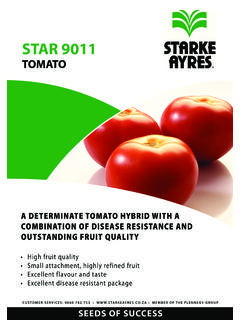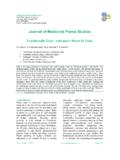Transcription of DISEASE CONTROL FOR HOME CHERRY ORCHARDS
1 Dr. Sharon M. Douglas Department of Plant Pathology and Ecology The connecticut Agricultural Experiment Station 123 Huntington Street, P. O. Box 1106 New Haven, CT 06504 Phone: (203) 974-8601 Fax: (203) 974-8502 Email: DISEASE CONTROL FOR home CHERRY ORCHARDS The diseases that commonly occur year after year in both commercial and backyard plantings of sweet and sour CHERRY in connecticut are brown rot, black knot, and leaf spot. These diseases do not infect at the same time but appear in a fairly regular sequence depending upon the weather and the development or phrenology of the CHERRY host, beginning at dormancy and continuing until fruit are harvested.
2 As a consequence, a season-long program for DISEASE management is often necessary in order to harvest a high percentage of useable fruit. Weather conditions greatly influence both the occurrence and severity of plant diseases. Consequently, diseases are generally most difficult to CONTROL in years of prevailing high temperature, high humidity, and abundant rainfall and cloud-cover. I. CONTROL STRATEGIES: CHERRY diseases can be effectively managed through the combined use of culture, sanitation, resistance, and fungicide sprays.
3 This integrated approach to DISEASE CONTROL minimizes the reliance upon one type of CONTROL over the others and usually results in a high percentage of quality fruit. A. CULTURE- Cultural methods include maintaining tree vigor by proper planting, fertilizing, and pruning and by following general practices that help to minimize tree stress. B. SANITATION- Sanitation involves pruning and removing affected or dead portions of the tree and removing diseased foliage or fruit which are often important sources of inoculum for the next season.
4 C. RESISTANCE- Resistance involves selection and planting of varieties with genetic resistance to specific diseases. This effectively reduces or eliminates occurrence of the DISEASE in question. However, to date, all commercially available cultivars of CHERRY are susceptible to brown rot and leaf spot although some are more susceptible than others. Breeding programs are currently underway to produce acceptable resistant cultivars for the United States. D. FUNGICIDE SPRAYS- Proper selection, timing, and application of these sprays are important.
5 Thorough coverage of all parts of the tree is necessary and sprays should be applied until run-off. The fungicide label 2will contain information on plant hosts and diseases, dosage rates, days to harvest interval, and safety precautions. II. COMMON DISEASES: A. BROWN ROT- Brown rot, caused by the fungus Monilinia fructicola, is the most common and destructive DISEASE of CHERRY in connecticut and New England. The DISEASE is especially severe in wet, humid weather. Brown rot causes blossom blights, twig blights, twig cankers, and fruit rots.
6 Infected blossoms wilt, shrivel, and die, becoming covered with a grayish mold. Infection can then spread to the twig and form a brownish oval canker. These cankers can expand and eventually girdle the twig, causing the terminal growth to wither and die. On fruit, symptoms first appear as a small, circular brown spots that increase rapidly in size and eventually result in a soft rot of the entire fruit. Under wet, humid conditions, ash-gray, powdery tufts appear all over the surface of the fruit, a characteristic diagnostic symptom of this DISEASE .
7 Fruit decay is often not apparent on immature fruit but becomes obvious as fruit begin to ripen. Fruit which are wounded (by insects, mechanical injury, bird pecks, etc.) are more readily infected than unwounded fruit. Rotted fruit may fall to the ground or persist as mummies on the tree. The fungus overwinters in fruit mummies on the tree or ground and in twig cankers. In spring, the fungus produces two types of spores; one type is produced on the surface of cankers and mummied fruit on the tree and the other type is produced in mummied fruit on the ground.
8 Both spore types can cause infection under warm, moist conditions. Sanitation is essential to CONTROL of brown rot. Any mummied fruit that remain on the tree should be removed and destroyed and all dead and/or cankered twigs should be pruned and removed from the vicinity of the tree or planting. In addition, all mummied fruit on the ground should be raked and removed and/or the ground beneath the tree cultivated to prevent spores from forming on the mummies in the spring. In conjunction with this sanitation program, a season-long fungicide spray program is usually necessary for effective brown rot CONTROL .
9 Properly selected and timed fungicide applications should be made to protect blossoms, foliage, and fruit throughout the growing season. Pre-harvest sprays are particularly important as fruit begin to ripen. Refer to spray guide on page 5. At harvest, care should be taken to avoid bruises, punctures, or tears in the skin of mature fruit to prevent sites for potential infection. Additionally, use only clean containers and cool fruit as soon as possible. B. LEAF SPOT- CHERRY leaf spot, caused by the fungus Blumeriella jaapii (formerly Coccomyces hiemalis), is also known as shot-hole of CHERRY .
10 This DISEASE is the most important DISEASE of sour CHERRY in New England although sweet CHERRY is also quite susceptible. Leaf spot reduces flower bud survival and can decrease fruit set on heavily infected trees. Symptoms first appear on the upper surface of the leaf as small, purple spots. These spots develop definitive margins or borders and gradually turn brown with age. Spots on sweet CHERRY are often larger and more circular than those on sour CHERRY . Infected leaves turn yellow and drop, often resulting in premature defoliation.


















